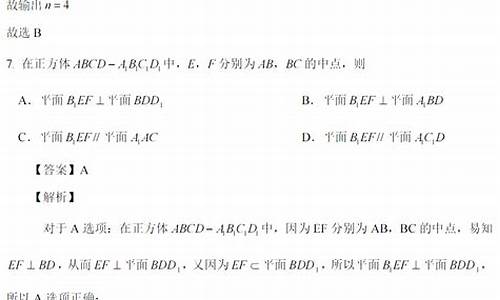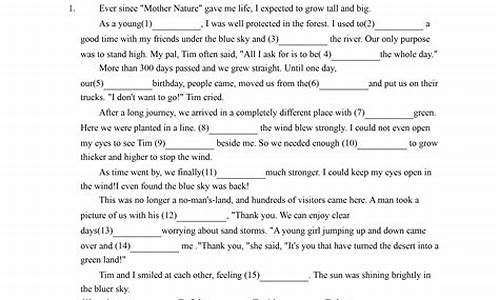您现在的位置是: 首页 > 高考动态 高考动态
高考英语算分公式,分词高考英语2024
tamoadmin 2024-07-13 人已围观
简介1.倒装句和情态动词笔记 本文节选自外刊《自然》(Nature / News / Article / 18 February 2022)Asteroids, Hubble rival and Moon base: China sets out space agenda——小行星、哈勃望远镜的竞争对手和月球基地:中国制定了太空议程。 文章下半部分节选内容如下:
1.倒装句和情态动词笔记

本文节选自外刊《自然》(Nature / News / Article / 18 February 2022)Asteroids, Hubble rival and Moon base: China sets out space agenda——小行星、哈勃望远镜的竞争对手和月球基地:中国制定了太空议程。
文章下半部分节选内容如下:
Asteroids, Hubble rival and Moon base: China sets out space agenda
小行星、哈勃望远镜的竞争对手和月球基地:中国制定了太空议程
Mars and beyond
火星和更远的地方
China made its first leap into interplanetary space with the Tianwen-1 orbiter, which dropped a lander containing the Zhurong rover on Mars in May.
今年5月,中国发射的“天问一号”轨道飞行器在火星上扔下了一个载有“祝融”号探测器的着陆器,这是中国首次进入行星际空间。
According to the white paper, China will complete research for sending a craft to Mars to sample rocks and return them to Earth.
根据白皮书,中国将完成向火星发送航天器以集岩石样本并将其返回地球的研究。
This mission could launch in 2028. (NASA’s Perseverance rover collected the first Mars rocks in 2021. The agency hopes to bring them back to Earth as part of a joint mission with the European Space Agency (ESA), launching in 2026.)
这项任务可能在2028年发射。(美国宇航局的毅力号火星车在2021年收集了第一批火星岩石。该机构希望将它们带回地球,作为与欧洲航天局(ESA)联合任务的一部分,于2026年发射。)
The white paper also lays out China’s plans to eventually probe further into the solar system. The next five years will see the completion of key research for a mission to explore Jupiter and its ocean-filled moon system.
白皮书还列出了中国最终进一步 探索 太阳系的。接下来的五年将见证 探索 木星及其充满海洋的卫星系统的关键研究的完成。
Press reports suggest that this mission could launch as early as 2029 — meaning that it would join ESA’s JUICE and NASA’s Europa Clipper mission, scheduled to fly in 2023 and 2024.
媒体报道称,这项任务最早可能在2029年发射——这意味着它将加入欧空局的JUICE和美国宇航局的Europa Clipper任务,在2023年和2024年飞行。
“Deep space is certainly another area China sees there are a lot of opportunities for scientific breakthroughs,” says Zhang.
“深空无疑是中国认为有很多科学突破机会的另一个领域,”张说。
The country has also set its sights on exploring the boundary of the Solar System.
该国还着眼于 探索 太阳系的边界。
China’s funding agencies he yet to confirm this, or the Jupiter mission, but “a mention in the plan is certainly helpful”, says Zhan Hu, an astronomer at the National Astronomical Observatories in Beijing.
中国的资助机构尚未确认这一点或木星任务,但北京国家天文台的天文学家詹虎说,“在中提及这一点肯定是有帮助的”。
重点词汇
leap跳;跳跃;跳过;跳越;飞快移动;突然行动;急不可待地行动;急切接受;飞涨;急剧增长;剧增;突然改变;猛涨;突然转换;越过(或起跳)处
interplanetary星际的;星际飞行的
orbiter轨道飞船
lander登陆车
rover流浪者;漫游者;自由队员;越野车;飞行器;月面车;天体登陆车;满门球;远距箭靶;VENTURE SCOUT的原称;海盗;海盗船;三道粗纱机操作工人;三道粗纱机
perseverance坚持不懈;锲而不舍;毅力
space agency空间机构;太空局、航天局;航天机构
lays位置;性伙伴;叙事诗;(lay的复数);放下;铺设;与…;航行;产卵;(lay的第三人称单数)
solar system太阳系
press reports新闻报告;媒体报道;报刊报道
A new Hubble: the Xuntian space telescope
新哈勃: “巡天”太空望远镜
China also plans to launch a space telescope called Xuntian, whose name means ‘survey the heens’.
中国还发射一个名为“巡天”的太空望远镜,其名字的意思是“巡天”。
This will image in the same welengths — ultriolet, visible and infrared — as those used by NASA’s Hubble Space Telescope.
这将在与美国宇航局哈勃太空望远镜相同的波长下成像——紫外线、可见光和红外线。
Slightly smaller than Hubble, Xuntian will not quite match its predecessor’s resolution; but, at any one time, Xuntian will capture a patch of sky 300 times larger.
巡天比哈勃稍小一些,它的分辨率将无法与哈勃媲美;但在任何时候,巡天望远镜都能捕捉到比它大300倍的天区(其视角将是哈勃的300多倍)。
That will allow it to probe a much greater volume of the Universe than Hubble, says Zhan, who works on Xuntian.
“巡天”项目工作人员詹说,这将使它能够探测到比哈勃探测到的大得多的宇宙天体。
Most of Xuntian’s first 10 years will be devoted to understanding the history and evolution of the Universe through a wide survey of the sky.
“巡天”望远镜工作前十年的大部分时间将致力于通过对天空的广泛观察来了解宇宙的 历史 和演化。
The telescope will periodically dock with China’s space station, Tiangong, for refuelling and maintenance.
该望远镜将定期与中国的天宫空间站对接,以加油并进行维护。
Zhan says that the team plans to deliver the telescope by the end of 2023, ready for launch in 2024. “The schedule is very tight,” he says.
詹说,该团队在2023年底交付望远镜,为2024年发射做准备。“时间安排很紧,”他说。
重点词汇
space telescope空间望远镜
telescope望远镜;使叠缩;使嵌进;叠缩;嵌进;使(车辆)相撞而嵌进;缩短;精简
heens天空;天堂;(heen的复数)
welengths波长;波段;(welength的复数)
ultriolet紫外的;利用紫外线的;产生紫外线的;紫外光;紫外辐射
predecessor前任;前辈;前身;原有事物
any one任何一;任何一个;任一
periodically定期地;周期性地;偶尔
dock码头;船埠;被告席;栏;酸模属草类;酸模;草本植物;动物尾巴(除毛发外的)骨肉部分;港区;靠码头;进港;扣除;扣减;领(船)入港;在太空与太空站(或另一艘飞船)对接;将(仪器)相接;剪短;剪短…尾巴
space station宇宙空间站
Detecting gritational wes in space
探测太空中的引力波
China wants to further develop plans to launch a space-based gritational-we detector, called Taiji, in the early 2030s.
中国希望进一步发展,在21世纪30年代初发射一个名为“太极”的天基引力波探测器。
If launched then, it would be the first of its kind. Such a mission would observe lower-frequency wes than those seen by ground-based detectors such as Advanced LIGO, allowing it to detect higher-mass black holes, including those in the early Universe.
如果届时发射成功,它将是首个天基引力波探测器。与高新激光干涉仪引力波天文台等地面探测器相比,天基探测器将观测到频率更低的波,使其能够探测质量更大的黑洞,包括早期宇宙中的黑洞等。
But the experiment would be complex: spotting ripples in space-time will mean detecting shifts of just a few trillionths of a metre in the distances between three spacecraft, positioned 3 million kilometres apart from each other in the shape of a triangle.
但是实验将会很复杂:发现时空中的波纹将意味着检测三个航天器之间距离的几万亿分之一米的变化,这三个航天器以三角形的形式彼此相距300万公里。
重点词汇
gritational重力的;引力的
of its kind同类之中
ground-based陆基的;基于地面的;以地面为基础的
detectors探测器;发现者;检测器;侦察器;(detector的复数)
black holes黑洞;地牢;禁闭室
spotting看见;看出;注意到;发现;让分;让子;让步;玷污;认出;弄上污迹;散步;(spot的现在分词);测定点位
ripples涟漪;(ripple的复数)
space-time空间时间关系;时空
metre米;韵律;格律;节拍;…米比赛
in the shape of以…形式表现;通过…形式;具有…性质
An initial pilot satellite, called Taiji-1, completed its mission successfully in 2019, and researchers now hope to fly a two-satellite mission in 2024–25 to test the necessary precision technologies.
一颗名为“太极一号”的初始试验卫星在2019年成功完成了任务,研究人员现在希望在2024-25年执行双卫星任务,以测试必要的精密技术。
This will “remove all the technical obstacles” for the ultimate Taiji mission, says Yue-Liang Wu, a physicist at the University of the Chinese Academy of Sciences in Beijing.
中国科学院大学物理学家吴岳良说,这将“为最终任务扫除所有技术障碍”。
ESA has long planned its own gritational-we observatory, LISA, and has already flown a successful pathfinder.
欧空局早就建立自己的天基引力波探测器LISA,并且已经成功发射了探路者号引力波试验探测器。
But LISA is not scheduled to launch until 2037.
但是LISA在2037年前发射。
Together, the two networks could be used to measure the Hubble constant, which describes the expansion of the Universe, with much greater accuracy than ground-based detectors can, say researchers behind the mission.
该任务背后的研究人员表示,“太极”和LISA这两个网络可以强强联手,一起用于测量哈勃常数(该常数描述宇宙的膨胀,比地面探测器更精确)。
重点词汇
hope to希望;希望能;希望以
physicist物理学家;物理学学生
sciences科学研究;科学;(science的复数)
observatory天文台;观象台;视野开阔的位置
flown飞;飞行;在空中快速移动;(fly的过去分词);空运
pathfinder探路者; 探索 者;开拓者;实验;预测;(Pathfinder)探路者号
universe天地万物;宇宙;领域;体系;范围
ground-based陆基的;基于地面的;以地面为基础的
detectors探测器;发现者;检测器;侦察器;(detector的复数)
基于多年的语言学习实践,发现,随着 社会 的飞速发展,英语、汉语等重要语言也在不断的与时俱进。这个时候,我们以不变应万变的方法之一,可以是阅读主流刊物。
针对英语而言,无论是为了提高英语水平还是备考任何英语考试,英美外刊都应该是列为首选的最重要的学习资料。当我们真正深入去精读过英美外刊,不仅可以了解英语国家的文化,增长我们的见识,对于英语学习来说,还能够积累以英语为母语者的常用词汇,短语和句型。
建议大家在阅读本文时:第一遍快速阅读,领悟文章重点,了解大意;第二遍开始精读,每看完一段,要仔细体会其中每一句在段落中的功能,各句之间的联系,这一段是如何衔接上下文的,它在整个语篇中的地位,以提高你猜测词义和推理上下文能力;第三遍可以查看中英翻译,继续从微观到宏观地理解原文,学会区分重点和次要信息(这对考试时的阅读非常重要),总结词汇,搭配和句型,并且最好独自翻译一遍原文,以进一步加强理解。
最后建议大家要学以致用,利用从文章中学到的词汇,搭配,句型以及长难句结构进行造句,提高英文写作能力。
学习路径建议:金句记忆——关键词学习——拓展词汇训练——触类旁通——举一反三。
温馨提示:阅读完看着中文译文自己动手翻译出英文,然后将您译的英文与原文进行对比,以此来提升英文表达和句子结构的准确性和地道性。
倒装句和情态动词笔记
盲盒的英文翻译是Blind box
重点词汇:box
词语分析:
音标:英 [b?ks] 美 [bɑ?ks]?
n. 箱,盒子;包厢;一拳
vi. 拳击
vt. 装…入盒中;拳击;打耳光
短语:
gear box 齿轮箱
black box 黑盒子
例句:
This box will answer for a chair.
这个箱子可以当椅子用。
The boxes warmly lauded the famous violinist.
包厢内的观众为那位著名的小提琴家热烈鼓掌。
Hee the box onto the top shelf.
把这个箱子举到最上面一层搁板上。
近义词:
n. 箱,盒子;包厢;一拳? case,balcony
倒装句
一、完全倒装,即将谓语移到主语前。英语中构成完全倒装的情形主要有:
1. 以 here, there, now, then, out, in, up, down, off, away 等方向性副词开头的句子,且句子主语是名词时,句子用完全倒装。如:
Here comes the bus. 公共汽车来了。
Now comes your turn. 现在该你了。
Then came a new difficulty. 这时又产生了一个新的困难。
The door opened and in came Mr Li. 门开了,李先生进了来。
注:若主语为代词,则不用倒装。如:
The door opened and in she came. 门开了,她走了进来。
2. 将表语和地点状语(多为介词短语)置于句首加以强调时,其后通常用倒装语序。如:
Among them was my friend Jim. 他们当中就有我的朋友吉姆。
Around the lake are some tall tree. 湖的四周有些高树。
注:在表语置于句首的倒装结构中,要注意其中的谓语应与其后的主语保持一致,而不是与位于句首的表语保持一致。
3. 状语或表语位于句首时的倒装
为了保持句子平衡或使上下文衔接紧密,有时可将状语或表语置于句首,句中主语和谓语完全倒装:
Among these people was his friend Jim. 他的朋友吉姆就在这些人当中。
4. 分词和不定式置于句首的倒装
有时为了强调,可将谓语部分的现在分词、过去分词或不定式置于句首,从而构成倒装:
Buried in the sands was an ancient village. 一个古老的村庄被埋在这沙土之中。
二、部分倒装,即将主语与助动词倒置,其结构与一般疑问句大致相同。英语中构成部分倒装的主要情形有:
1. 含否定意义的词(如 never, hardly, seldom, little, few, not until, not, not only, no sooner, no longer, nowhere, by no means 等)置于句首时,其后用部分倒装。如:
Never he I seen read such a book. 我从未读过那样的书。
Little do we know his life. 我们对他的生活了解得很少。
By no means should you tell him about it. 你绝不要告诉他这事。
2. only 加状语(副词 / 介词短语 / 从句)放在句首时,其后用部分倒装。如:
Only in this way can you do it well. 只有这样你才能做好。
Only when he returned home did he realize what had hened. 当他回到家里时,才知道出了什么事。
3. so / neither / nor 表示前面所说的情况也适合于后者时,用“so / neither / nor+助动词+主语”这样的倒装句式。如:
He can sing English songs and so can I. 他会唱英语歌,我也会。
He didn’t see the film, and neither did I. 他没有看这部**,我也没有看。
She is every beautiful and so was her mother when she was young. 她很美,她妈妈年轻时也很美。
4. 当虚拟条件句含有 were, should, had 时,可省略 if,将 were, should, had 置于句首。如:
Were I Tom(=If I were Tom), I would refuse. 如果我是汤姆,我就会拒绝。
Had I realized that(=If I had realized that), I would he done something. 我要是明白了这一点,我可能会取某种行动(from .yygrammar)。
5. so...that 结构中,将 so+adj. / adv. 置于句首时,其后要用倒装语序。如:
So cold was the weather that we had to stay at home. 天气太冷,我们只好呆在家里。
So fast does light trel that we can hardly imagine its speed. 光速很快,我们几乎没法想像它的速度。
三、常见倒装类型
1.as作“虽然”解,引导让步状语从句时,必须将表语、状语或动词原形提到as前面。此时应注意几点:一是若提前的表语是没有形容词修饰的单数可数名词,要省略不定冠词;二是若提前的是动词原形(多为不及物动词),与之连用的通常是may, might, will, would等,且这些词都要保留在原来的位置上(主语后);三是though有时也可像as这样使作倒装。如:
Tired as I was, I tried to help them. 虽然我很累,我还是努力帮助他们。
2.在so... that…结构中,若将so+adj. / adv. 置于句首,则其后的主句要用部分倒装。如:
So cold was the weather that we had to stay at home. 天气太冷,我们只好呆在家里。
3.so / neither / nor表示前面所说的情况也适合于后者时,其句型是:so / neither / nor+特殊词+主语。使句此句型需注意以下几点:①内容是肯定时,用so,内容是否定时,用neither或nor;②“特殊词”与前句中的情态动词、助动词或be相同,或根据前句的时态,用do, does, did;③“特殊词”的人称和数与其后的主语一致;④“特殊词”本身没有否定形式。如:
You are young and so am I. 你年轻,我也年轻。
4.当“only+状语”位于句首时,其后习惯上要用部分倒装。其中,only后的状语可以是副词、介词短语、从句等。
Only in this way can we learn English. 只有这样才能学会英语。
Only then did I understand what she meant. 只有到那时我才明白她的意思。
Only by shouting was he able to make himself heard. 他只有叫喊才能让别人听到他。
注意,在only后作状语的是从句时,从句不要用倒装,要部分倒装的是主句。如:
Only when it rains do you feel cool. 只有下雨时才觉得凉爽一点。
5.not only…but also…前后连接两个句子时,not only后的句子要用部分倒装,但but also后的分句不用倒装。如:
Not only did he come, but he saw her. 他不仅来了,而且还见到了她。
6.按英语习惯,当never, hardly, seldom, little, few, not until, not, no, no sooner, by no means, under no circumstances等否定词置于句首时,其后要用部分倒装。如:
Never did I see him again. 后来我再也没见到过他了。
Little did I dream that the girl was my niece. 我做梦也没想到那女孩是我的侄女。
情态动词
1. 弄清基本语法特点
情态动词就是表示说话的语气或情态的动词。常见的情态动词有can, may, must, need, dare, shall, will, should, ought to, he to, used to, had better, would rather等。情态动词具有以下3个特点:
(1) 情态动词后面接动词原形并与动词原形一起构成谓语。
(2) 情态动词虽有时态的变化,但却没有人称和数的变化,即情态动词不会因为主语的人称或单复数的不同而用不同的形式。
(3) 变为疑问句或否定句时不需要助动词,而是将情态动词移至主语前变为疑问句,直接在情态动词后加not,构成否定句。
2. 弄清表示能力的can / could和be able to的用法
(1) can表示具有某种能力或技能,意为“能,会”。如:
Who can answer this question? 谁能回答这个问题?
(2)can 的过去式为could,但它通常只表示过去一般性能力,不表示过去特定场合下的能力,遇此情况要用 was [were] able to。如:
I could run faster then. 我那时能跑得更快一些。
They were able to jump into the sea before the boat was blown up. 他们在船爆之前跳入海里。
3. 弄清表示许可的can / could / may / might / must的用法
can / could / may / might均可表示许可,只不过may较侧重讲话人的许可,而can较侧重客观情况的许可;could / might的语气比can / may更委婉、客气;在答语中表示允许别人做某事要can / may,不能用 could / might。如:
— Could [Can, May, Might] I use it? 我可以借用它吗?
— Yes, you can [may]. 可以。(不用 could / might)
must 表示必须作某事,其否定式mustn’t表示“不可以”。如:
We must not speak of it again. 我们再也不要谈这事了。
4. 弄清表推测的 can / may / could / might / should / must的用法
(1) 从所用句型来看:can用于否定句和疑问句,may用于肯定句和否定式,两者均可用于否定句,但是含义不同(cannot=不可能,may not=可能不);could, might 和 should 可用于肯定句、否定句和疑问句;must 表示推测通常只用于肯定句。如:
She can’t be in the office now. 她现在不可能在办公室。
She may not be free tonight. 她今晚可能没空。
He may [might] come tonight. 他今晚可能会来。
Might he know this? 他会知道这事吗?
(2) 从语气上看,can / may / could / might 的语气较不确定,尤其是might, could,其意很不肯定;should表示推测时,其语气比较肯定,它通常指非常可能的事,并暗示其推测有一定的事实依据或者合乎常理;must 表示推测的语气最肯定。注意有时高考也会对这种语气上的差异命题,如下面这道高考题:
“When can I come for the photos? I need them tomorrow afternoon.” “They _________ be ready by 12:00.”
A. can B. should C. might D. need
在四个选项中,首先可排除A和D,因为它们通常不用肯定句中;而B和C均可用于肯定句表示推测,但根据句意:顾客下午要照片,此时店主显然应用语气较肯定的should,而不宜用语气很不肯定的 might,否则顾客是不会满意的。
5. 弄清shall 与 will 的用法
(1) shall 除用于第一人称表示单纯将来外,还可用于陈述句第二、三人称, 表示说话者的意图、警告、命令、决心等。如:
You shall he an answer by tomorrow. 到明天你可以得到答复。
He shall he a bicycle for his birthday. 他可以得到一辆自行车作为生日礼物。
(2) will 可以表示习惯和倾向性,意为“惯于, 老是, 终归是”如:
The door won’t open. 这门打不开。
Matches will not strike if they are damp. 火柴潮湿就擦不着。
(3) Shall I (we)…? 可用于征求意见等,Will you…?可用于表示请求或邀请等。如:
Shall I turn on the light? 要不要把灯打开?
Will you join us for dinner? 你可否和我们一道去吃晚饭?
6. 弄清must表示“偏偏”的用法
情态动词 must 有时可以表示固执、偏激或碰巧,通常可译为“偏偏”。如:
After I ge her my advice, she must go and do the opposite. 在我给她出主意之后她偏反着干。
The car must break down just we were starting our holidays. 我们刚刚开始休,汽车偏偏坏了。
7. need和dare的用法要点
need和dare可用作实义动词和情态动词,用作实义动词时,后接动词要用不定式,有人称和数的变化,可用肯定句、否定句和疑问句;用作情态动词时,主要用于否定句和疑问句中,没有人称和数的变化,后接动词要用动词原形。如:
You need not pay—it is free. 你不必付钱,这是免费的。
We need to he lots of patience. 我们需要有很大的耐心。
Who would dare to tell him? 谁会敢告诉他?
He dared not go there at night. 晚上他不敢到那里去。
How dare you ask me such a question? 你怎么敢问我这样的问题?
注:need 表示“需要”,其后可接动名词,且要用主动形式表示被动意义。如:
The room needs cleaning. 这房间需要打扫了。
8. 弄清“情态动词+完成式”的用法
(1) must + he done:用于肯定句,表示推测,意为“一定(已经)……”。
(2) can + he done:用于否定句或疑问句,表示推测,意为“可能(已经)……”。
(3) could + he done:可用于肯定句、否定句或疑问句,表示推测、责备或遗憾等,意为“可能……”“本来可以……”“本来应该……”等。
(4) should [ought to] + he done:可用于肯定句、否定句或疑问句,表示责备或遗憾等,意为“本来应该……”。
(5) need + he done:用于否定句或疑问句,用于否定时意为“本来不必”,用于疑问句时意为“有必要……吗”。
(6) may + he done:用于肯定句或否定句,表示推测,意为“可能(已经)……”。
(7) might + he done:用于肯定句或否定句,表示推测,意为“可能(已经)……(此时 might 可换为 may);另外还可以表示过去可能发生的事结果未发生,意为“本来会……”(此时 might 不能换为 may)。
He can’t he left so soon. 他不可能走得这么早。
I should he thought of it. 我本应想到这一点的。
You needn’t he mentioned it. 你没有必要提及此事的。
You must he mistaken my intention. 你一定是误会了我的意图。
I might he come to a wrong conclusion. 我或许得出了错误的结论。
You could he helped me—why did you just sit and watch? 你本可帮助我的,为什么只坐在一旁瞧着?
9. 弄清“情态动词+进行式”的用法
这类结构主要用于对一个正在进行的动作进行推测、责备、描述等。如:
He might be waiting for you. 他可能在等你(.yygrammar)。
You should be wearing your sunglasses. 你应当戴着你的太阳镜。
He must be joking, or else he’s mad. 他一定在说笑话,要不就是疯了。
10. 弄清may [might] as well和may [might] well的用法
(1) may [might] as well可用来提出建议等,可译为“不妨”(用might时口气更委婉一些)。如:
Catherine, you may as well come too. 凯瑟琳,你不妨也去。
If that’s the case, I may as well try. 如果情况如此,我不妨试一试。
(2) may [might] well可表示比较有把握的推测,意为“很可能”。如:
You might well be right. 你很可能是对的。
P.S.以上知识点应该比较全了,如果太多例句可以删减O(∩_∩)O~~









